Critical Analysis of the National Disability Insurance Scheme (NDIS)
VerifiedAdded on 2022/08/29
|7
|1647
|23
Report
AI Summary
This report provides a comprehensive analysis of the National Disability Insurance Scheme (NDIS) in Australia. It examines the scheme's objectives, which include supporting the independence and social inclusion of individuals with disabilities. The report delves into the historical context of social policies in Australia, highlighting the evolution of healthcare and disability support systems, including the introduction of Medibank, Medicare, and subsequent changes leading to the NDIS. It discusses the three-tiered intervention structure of the NDIS, its alignment with social work values, and the ideologies underpinning the scheme, emphasizing the importance of early intervention and the protection of individuals with disabilities from exploitation. Furthermore, the report considers the role of social policies in promoting the welfare of society, the rights of disabled individuals, and the involvement of the private sector in funding initiatives. The analysis also references key legislation and government initiatives, such as the National Disability Insurance Scheme Act of 2013. The report concludes that the NDIS is a significant step toward ensuring the rights and well-being of people with disabilities in Australia.
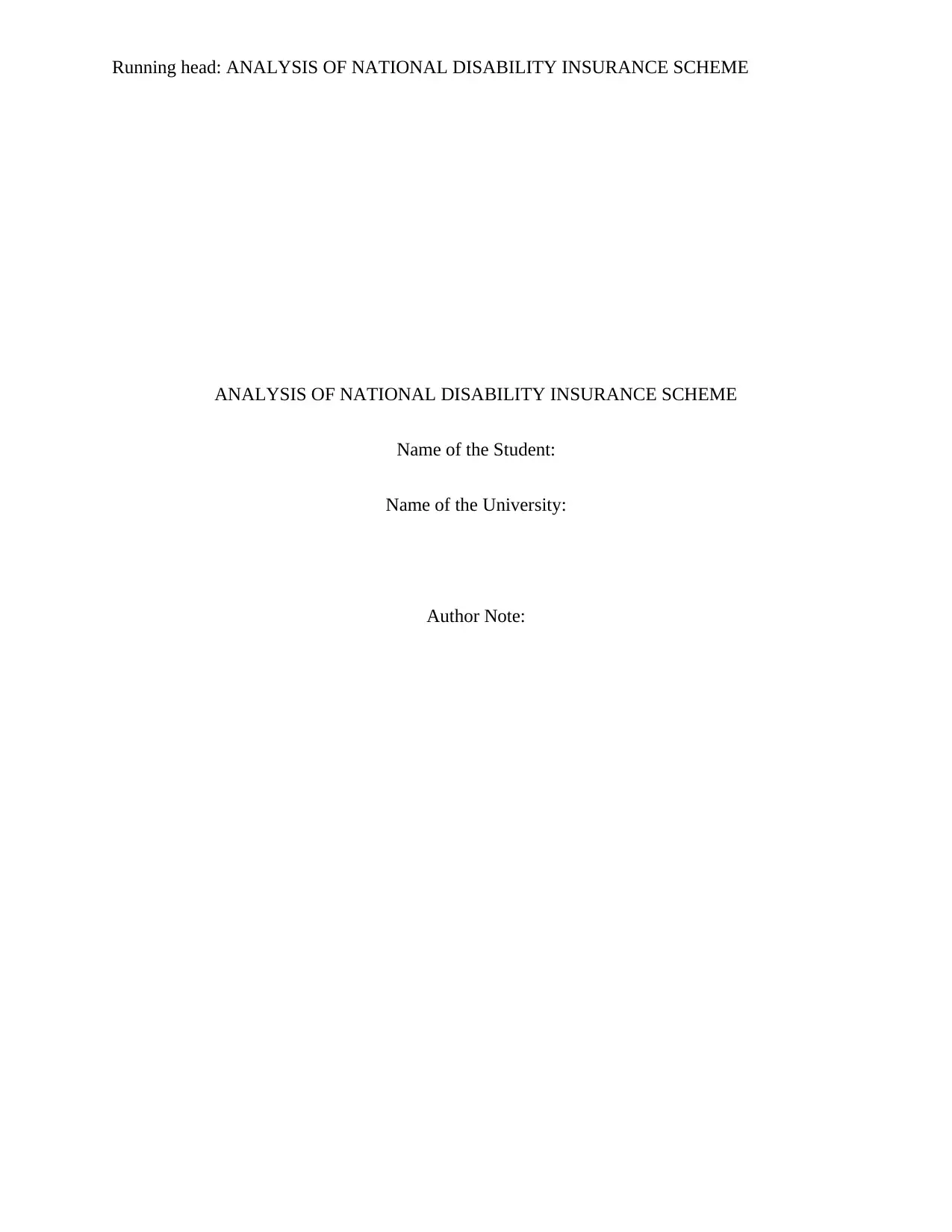
Running head: ANALYSIS OF NATIONAL DISABILITY INSURANCE SCHEME
ANALYSIS OF NATIONAL DISABILITY INSURANCE SCHEME
Name of the Student:
Name of the University:
Author Note:
ANALYSIS OF NATIONAL DISABILITY INSURANCE SCHEME
Name of the Student:
Name of the University:
Author Note:
Paraphrase This Document
Need a fresh take? Get an instant paraphrase of this document with our AI Paraphraser
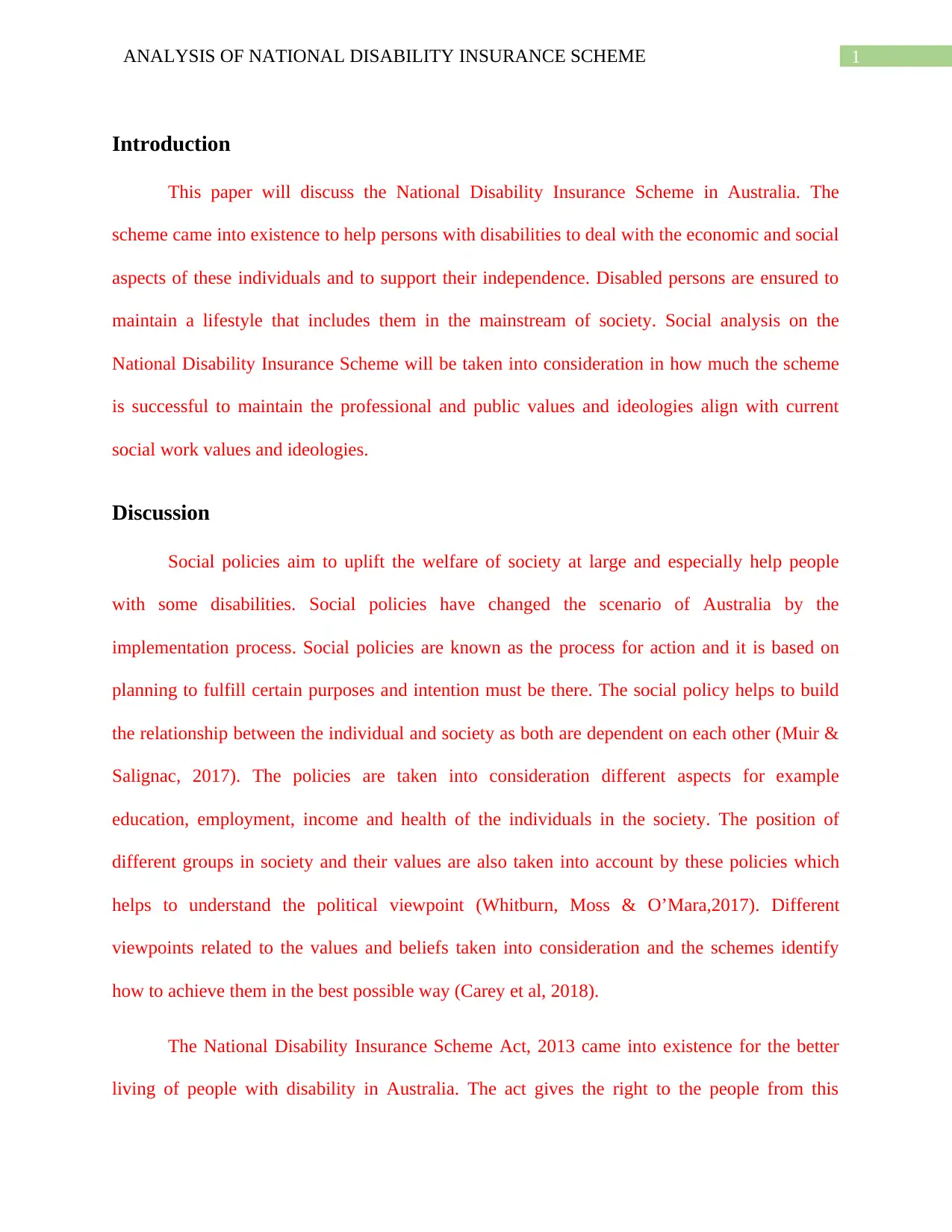
1ANALYSIS OF NATIONAL DISABILITY INSURANCE SCHEME
Introduction
This paper will discuss the National Disability Insurance Scheme in Australia. The
scheme came into existence to help persons with disabilities to deal with the economic and social
aspects of these individuals and to support their independence. Disabled persons are ensured to
maintain a lifestyle that includes them in the mainstream of society. Social analysis on the
National Disability Insurance Scheme will be taken into consideration in how much the scheme
is successful to maintain the professional and public values and ideologies align with current
social work values and ideologies.
Discussion
Social policies aim to uplift the welfare of society at large and especially help people
with some disabilities. Social policies have changed the scenario of Australia by the
implementation process. Social policies are known as the process for action and it is based on
planning to fulfill certain purposes and intention must be there. The social policy helps to build
the relationship between the individual and society as both are dependent on each other (Muir &
Salignac, 2017). The policies are taken into consideration different aspects for example
education, employment, income and health of the individuals in the society. The position of
different groups in society and their values are also taken into account by these policies which
helps to understand the political viewpoint (Whitburn, Moss & O’Mara,2017). Different
viewpoints related to the values and beliefs taken into consideration and the schemes identify
how to achieve them in the best possible way (Carey et al, 2018).
The National Disability Insurance Scheme Act, 2013 came into existence for the better
living of people with disability in Australia. The act gives the right to the people from this
Introduction
This paper will discuss the National Disability Insurance Scheme in Australia. The
scheme came into existence to help persons with disabilities to deal with the economic and social
aspects of these individuals and to support their independence. Disabled persons are ensured to
maintain a lifestyle that includes them in the mainstream of society. Social analysis on the
National Disability Insurance Scheme will be taken into consideration in how much the scheme
is successful to maintain the professional and public values and ideologies align with current
social work values and ideologies.
Discussion
Social policies aim to uplift the welfare of society at large and especially help people
with some disabilities. Social policies have changed the scenario of Australia by the
implementation process. Social policies are known as the process for action and it is based on
planning to fulfill certain purposes and intention must be there. The social policy helps to build
the relationship between the individual and society as both are dependent on each other (Muir &
Salignac, 2017). The policies are taken into consideration different aspects for example
education, employment, income and health of the individuals in the society. The position of
different groups in society and their values are also taken into account by these policies which
helps to understand the political viewpoint (Whitburn, Moss & O’Mara,2017). Different
viewpoints related to the values and beliefs taken into consideration and the schemes identify
how to achieve them in the best possible way (Carey et al, 2018).
The National Disability Insurance Scheme Act, 2013 came into existence for the better
living of people with disability in Australia. The act gives the right to the people from this
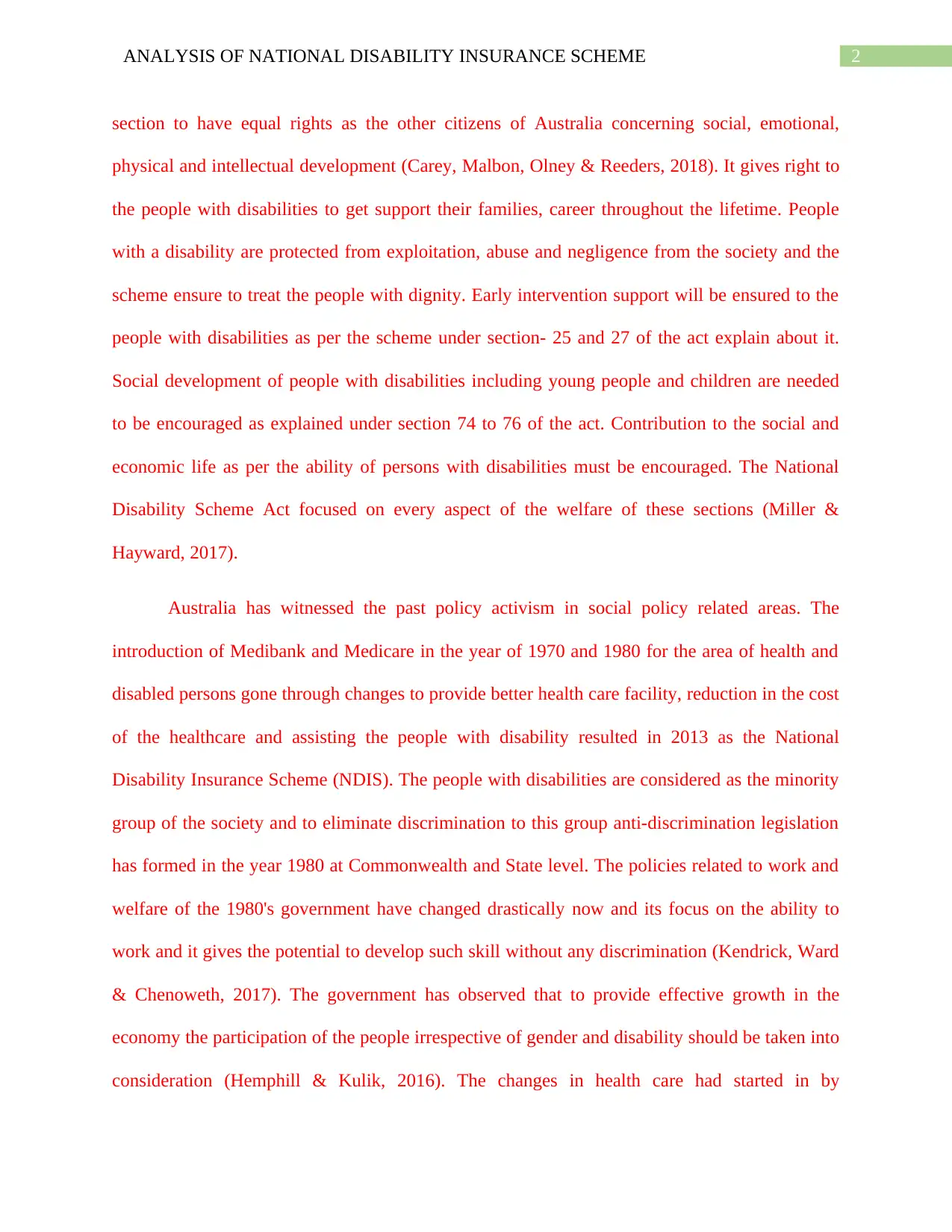
2ANALYSIS OF NATIONAL DISABILITY INSURANCE SCHEME
section to have equal rights as the other citizens of Australia concerning social, emotional,
physical and intellectual development (Carey, Malbon, Olney & Reeders, 2018). It gives right to
the people with disabilities to get support their families, career throughout the lifetime. People
with a disability are protected from exploitation, abuse and negligence from the society and the
scheme ensure to treat the people with dignity. Early intervention support will be ensured to the
people with disabilities as per the scheme under section- 25 and 27 of the act explain about it.
Social development of people with disabilities including young people and children are needed
to be encouraged as explained under section 74 to 76 of the act. Contribution to the social and
economic life as per the ability of persons with disabilities must be encouraged. The National
Disability Scheme Act focused on every aspect of the welfare of these sections (Miller &
Hayward, 2017).
Australia has witnessed the past policy activism in social policy related areas. The
introduction of Medibank and Medicare in the year of 1970 and 1980 for the area of health and
disabled persons gone through changes to provide better health care facility, reduction in the cost
of the healthcare and assisting the people with disability resulted in 2013 as the National
Disability Insurance Scheme (NDIS). The people with disabilities are considered as the minority
group of the society and to eliminate discrimination to this group anti-discrimination legislation
has formed in the year 1980 at Commonwealth and State level. The policies related to work and
welfare of the 1980's government have changed drastically now and its focus on the ability to
work and it gives the potential to develop such skill without any discrimination (Kendrick, Ward
& Chenoweth, 2017). The government has observed that to provide effective growth in the
economy the participation of the people irrespective of gender and disability should be taken into
consideration (Hemphill & Kulik, 2016). The changes in health care had started in by
section to have equal rights as the other citizens of Australia concerning social, emotional,
physical and intellectual development (Carey, Malbon, Olney & Reeders, 2018). It gives right to
the people with disabilities to get support their families, career throughout the lifetime. People
with a disability are protected from exploitation, abuse and negligence from the society and the
scheme ensure to treat the people with dignity. Early intervention support will be ensured to the
people with disabilities as per the scheme under section- 25 and 27 of the act explain about it.
Social development of people with disabilities including young people and children are needed
to be encouraged as explained under section 74 to 76 of the act. Contribution to the social and
economic life as per the ability of persons with disabilities must be encouraged. The National
Disability Scheme Act focused on every aspect of the welfare of these sections (Miller &
Hayward, 2017).
Australia has witnessed the past policy activism in social policy related areas. The
introduction of Medibank and Medicare in the year of 1970 and 1980 for the area of health and
disabled persons gone through changes to provide better health care facility, reduction in the cost
of the healthcare and assisting the people with disability resulted in 2013 as the National
Disability Insurance Scheme (NDIS). The people with disabilities are considered as the minority
group of the society and to eliminate discrimination to this group anti-discrimination legislation
has formed in the year 1980 at Commonwealth and State level. The policies related to work and
welfare of the 1980's government have changed drastically now and its focus on the ability to
work and it gives the potential to develop such skill without any discrimination (Kendrick, Ward
& Chenoweth, 2017). The government has observed that to provide effective growth in the
economy the participation of the people irrespective of gender and disability should be taken into
consideration (Hemphill & Kulik, 2016). The changes in health care had started in by
⊘ This is a preview!⊘
Do you want full access?
Subscribe today to unlock all pages.

Trusted by 1+ million students worldwide
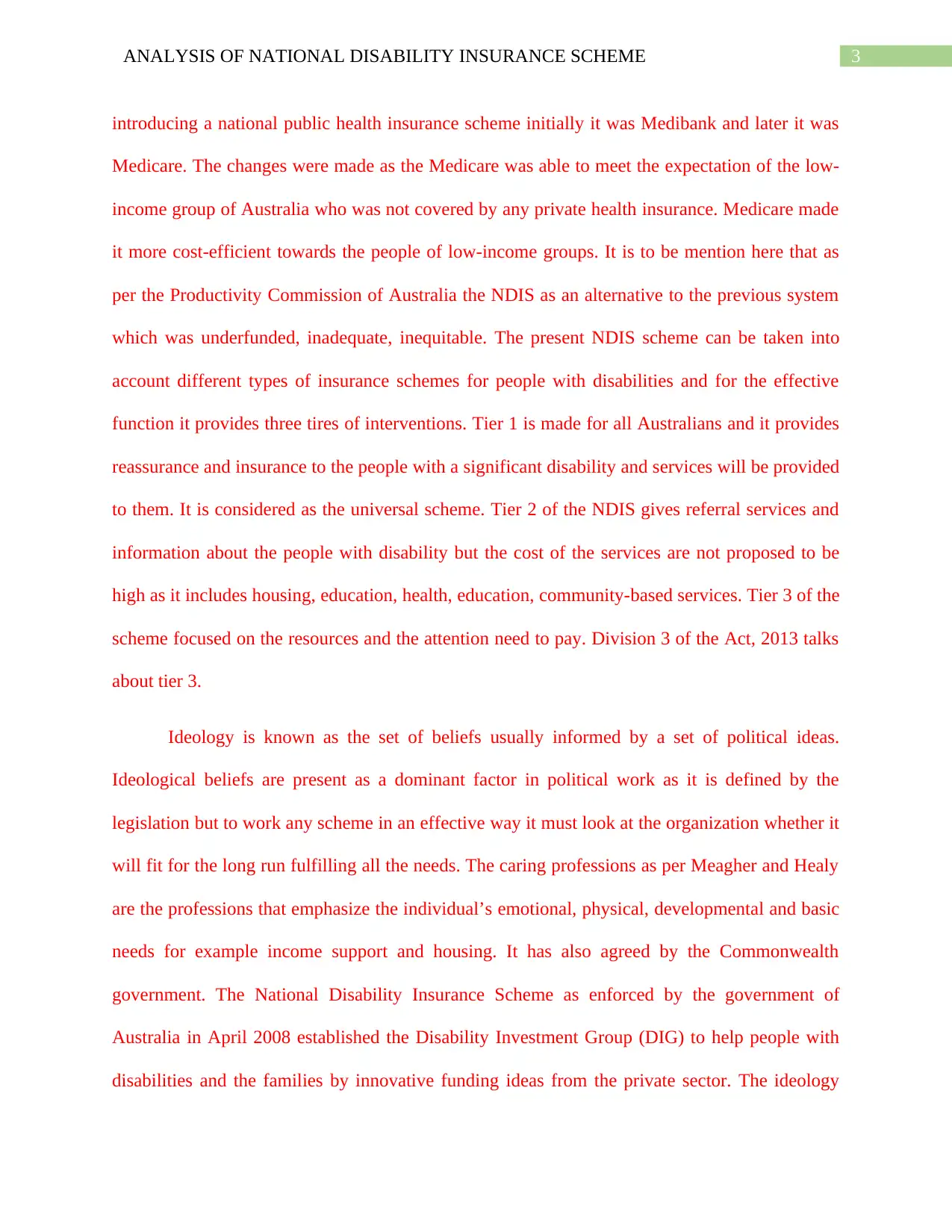
3ANALYSIS OF NATIONAL DISABILITY INSURANCE SCHEME
introducing a national public health insurance scheme initially it was Medibank and later it was
Medicare. The changes were made as the Medicare was able to meet the expectation of the low-
income group of Australia who was not covered by any private health insurance. Medicare made
it more cost-efficient towards the people of low-income groups. It is to be mention here that as
per the Productivity Commission of Australia the NDIS as an alternative to the previous system
which was underfunded, inadequate, inequitable. The present NDIS scheme can be taken into
account different types of insurance schemes for people with disabilities and for the effective
function it provides three tires of interventions. Tier 1 is made for all Australians and it provides
reassurance and insurance to the people with a significant disability and services will be provided
to them. It is considered as the universal scheme. Tier 2 of the NDIS gives referral services and
information about the people with disability but the cost of the services are not proposed to be
high as it includes housing, education, health, education, community-based services. Tier 3 of the
scheme focused on the resources and the attention need to pay. Division 3 of the Act, 2013 talks
about tier 3.
Ideology is known as the set of beliefs usually informed by a set of political ideas.
Ideological beliefs are present as a dominant factor in political work as it is defined by the
legislation but to work any scheme in an effective way it must look at the organization whether it
will fit for the long run fulfilling all the needs. The caring professions as per Meagher and Healy
are the professions that emphasize the individual’s emotional, physical, developmental and basic
needs for example income support and housing. It has also agreed by the Commonwealth
government. The National Disability Insurance Scheme as enforced by the government of
Australia in April 2008 established the Disability Investment Group (DIG) to help people with
disabilities and the families by innovative funding ideas from the private sector. The ideology
introducing a national public health insurance scheme initially it was Medibank and later it was
Medicare. The changes were made as the Medicare was able to meet the expectation of the low-
income group of Australia who was not covered by any private health insurance. Medicare made
it more cost-efficient towards the people of low-income groups. It is to be mention here that as
per the Productivity Commission of Australia the NDIS as an alternative to the previous system
which was underfunded, inadequate, inequitable. The present NDIS scheme can be taken into
account different types of insurance schemes for people with disabilities and for the effective
function it provides three tires of interventions. Tier 1 is made for all Australians and it provides
reassurance and insurance to the people with a significant disability and services will be provided
to them. It is considered as the universal scheme. Tier 2 of the NDIS gives referral services and
information about the people with disability but the cost of the services are not proposed to be
high as it includes housing, education, health, education, community-based services. Tier 3 of the
scheme focused on the resources and the attention need to pay. Division 3 of the Act, 2013 talks
about tier 3.
Ideology is known as the set of beliefs usually informed by a set of political ideas.
Ideological beliefs are present as a dominant factor in political work as it is defined by the
legislation but to work any scheme in an effective way it must look at the organization whether it
will fit for the long run fulfilling all the needs. The caring professions as per Meagher and Healy
are the professions that emphasize the individual’s emotional, physical, developmental and basic
needs for example income support and housing. It has also agreed by the Commonwealth
government. The National Disability Insurance Scheme as enforced by the government of
Australia in April 2008 established the Disability Investment Group (DIG) to help people with
disabilities and the families by innovative funding ideas from the private sector. The ideology
Paraphrase This Document
Need a fresh take? Get an instant paraphrase of this document with our AI Paraphraser
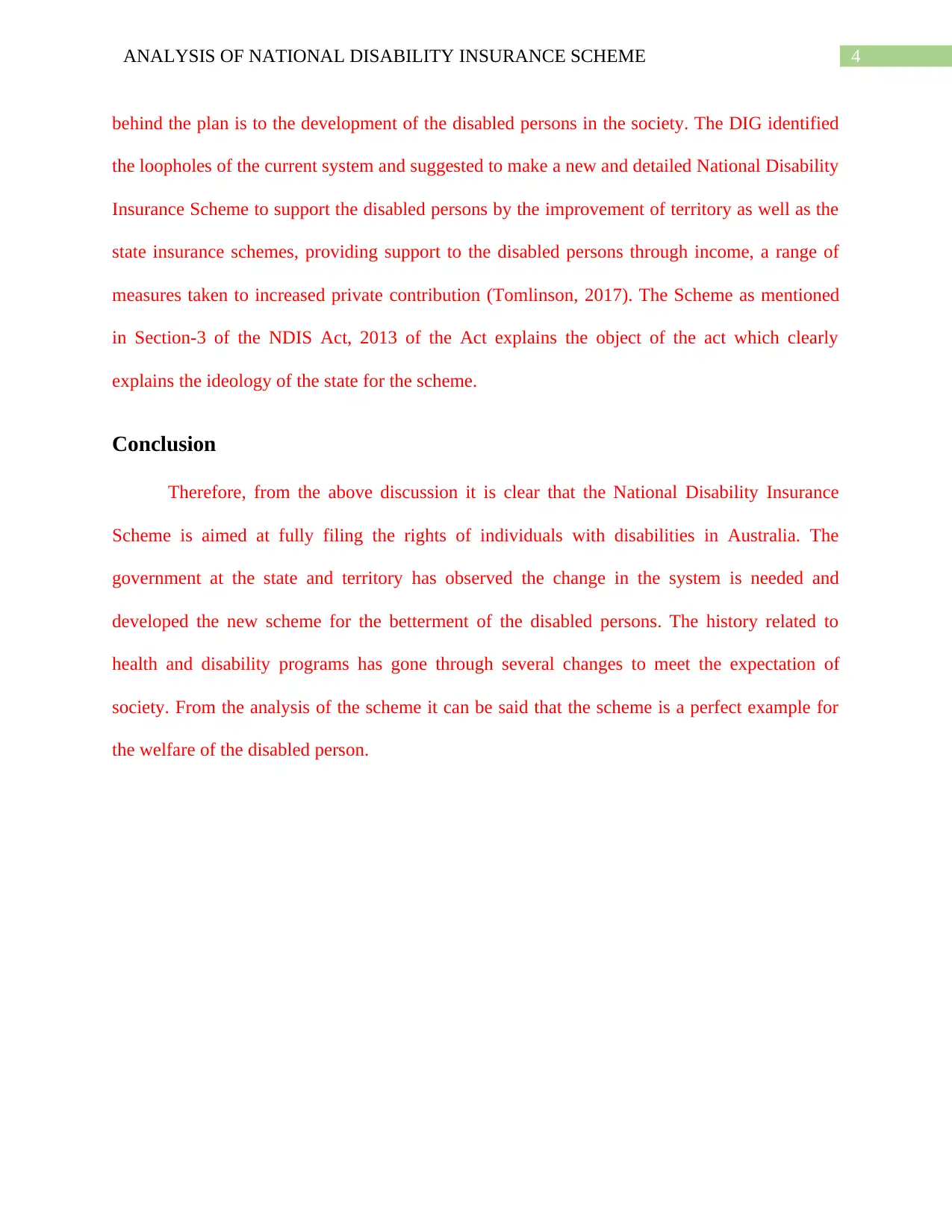
4ANALYSIS OF NATIONAL DISABILITY INSURANCE SCHEME
behind the plan is to the development of the disabled persons in the society. The DIG identified
the loopholes of the current system and suggested to make a new and detailed National Disability
Insurance Scheme to support the disabled persons by the improvement of territory as well as the
state insurance schemes, providing support to the disabled persons through income, a range of
measures taken to increased private contribution (Tomlinson, 2017). The Scheme as mentioned
in Section-3 of the NDIS Act, 2013 of the Act explains the object of the act which clearly
explains the ideology of the state for the scheme.
Conclusion
Therefore, from the above discussion it is clear that the National Disability Insurance
Scheme is aimed at fully filing the rights of individuals with disabilities in Australia. The
government at the state and territory has observed the change in the system is needed and
developed the new scheme for the betterment of the disabled persons. The history related to
health and disability programs has gone through several changes to meet the expectation of
society. From the analysis of the scheme it can be said that the scheme is a perfect example for
the welfare of the disabled person.
behind the plan is to the development of the disabled persons in the society. The DIG identified
the loopholes of the current system and suggested to make a new and detailed National Disability
Insurance Scheme to support the disabled persons by the improvement of territory as well as the
state insurance schemes, providing support to the disabled persons through income, a range of
measures taken to increased private contribution (Tomlinson, 2017). The Scheme as mentioned
in Section-3 of the NDIS Act, 2013 of the Act explains the object of the act which clearly
explains the ideology of the state for the scheme.
Conclusion
Therefore, from the above discussion it is clear that the National Disability Insurance
Scheme is aimed at fully filing the rights of individuals with disabilities in Australia. The
government at the state and territory has observed the change in the system is needed and
developed the new scheme for the betterment of the disabled persons. The history related to
health and disability programs has gone through several changes to meet the expectation of
society. From the analysis of the scheme it can be said that the scheme is a perfect example for
the welfare of the disabled person.
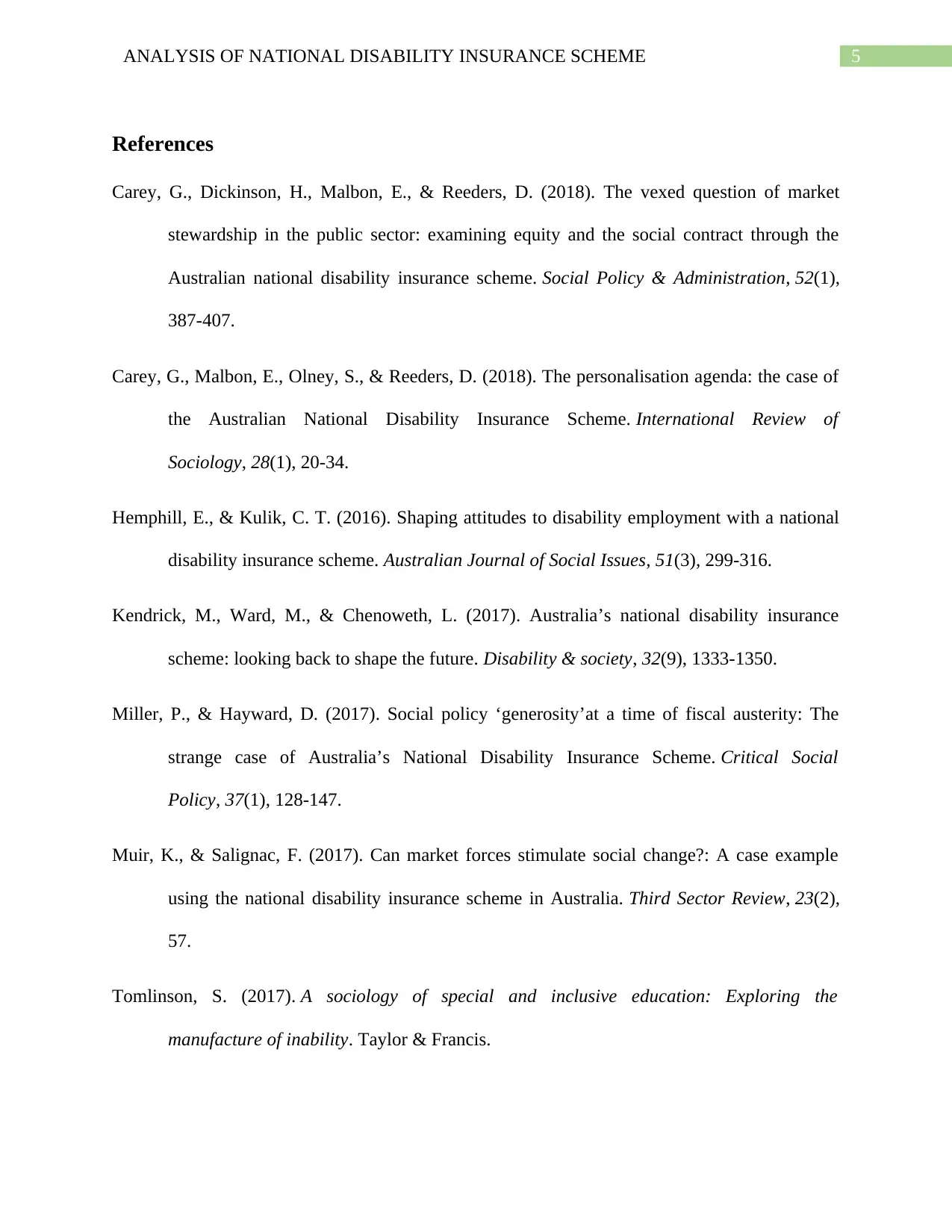
5ANALYSIS OF NATIONAL DISABILITY INSURANCE SCHEME
References
Carey, G., Dickinson, H., Malbon, E., & Reeders, D. (2018). The vexed question of market
stewardship in the public sector: examining equity and the social contract through the
Australian national disability insurance scheme. Social Policy & Administration, 52(1),
387-407.
Carey, G., Malbon, E., Olney, S., & Reeders, D. (2018). The personalisation agenda: the case of
the Australian National Disability Insurance Scheme. International Review of
Sociology, 28(1), 20-34.
Hemphill, E., & Kulik, C. T. (2016). Shaping attitudes to disability employment with a national
disability insurance scheme. Australian Journal of Social Issues, 51(3), 299-316.
Kendrick, M., Ward, M., & Chenoweth, L. (2017). Australia’s national disability insurance
scheme: looking back to shape the future. Disability & society, 32(9), 1333-1350.
Miller, P., & Hayward, D. (2017). Social policy ‘generosity’at a time of fiscal austerity: The
strange case of Australia’s National Disability Insurance Scheme. Critical Social
Policy, 37(1), 128-147.
Muir, K., & Salignac, F. (2017). Can market forces stimulate social change?: A case example
using the national disability insurance scheme in Australia. Third Sector Review, 23(2),
57.
Tomlinson, S. (2017). A sociology of special and inclusive education: Exploring the
manufacture of inability. Taylor & Francis.
References
Carey, G., Dickinson, H., Malbon, E., & Reeders, D. (2018). The vexed question of market
stewardship in the public sector: examining equity and the social contract through the
Australian national disability insurance scheme. Social Policy & Administration, 52(1),
387-407.
Carey, G., Malbon, E., Olney, S., & Reeders, D. (2018). The personalisation agenda: the case of
the Australian National Disability Insurance Scheme. International Review of
Sociology, 28(1), 20-34.
Hemphill, E., & Kulik, C. T. (2016). Shaping attitudes to disability employment with a national
disability insurance scheme. Australian Journal of Social Issues, 51(3), 299-316.
Kendrick, M., Ward, M., & Chenoweth, L. (2017). Australia’s national disability insurance
scheme: looking back to shape the future. Disability & society, 32(9), 1333-1350.
Miller, P., & Hayward, D. (2017). Social policy ‘generosity’at a time of fiscal austerity: The
strange case of Australia’s National Disability Insurance Scheme. Critical Social
Policy, 37(1), 128-147.
Muir, K., & Salignac, F. (2017). Can market forces stimulate social change?: A case example
using the national disability insurance scheme in Australia. Third Sector Review, 23(2),
57.
Tomlinson, S. (2017). A sociology of special and inclusive education: Exploring the
manufacture of inability. Taylor & Francis.
⊘ This is a preview!⊘
Do you want full access?
Subscribe today to unlock all pages.

Trusted by 1+ million students worldwide
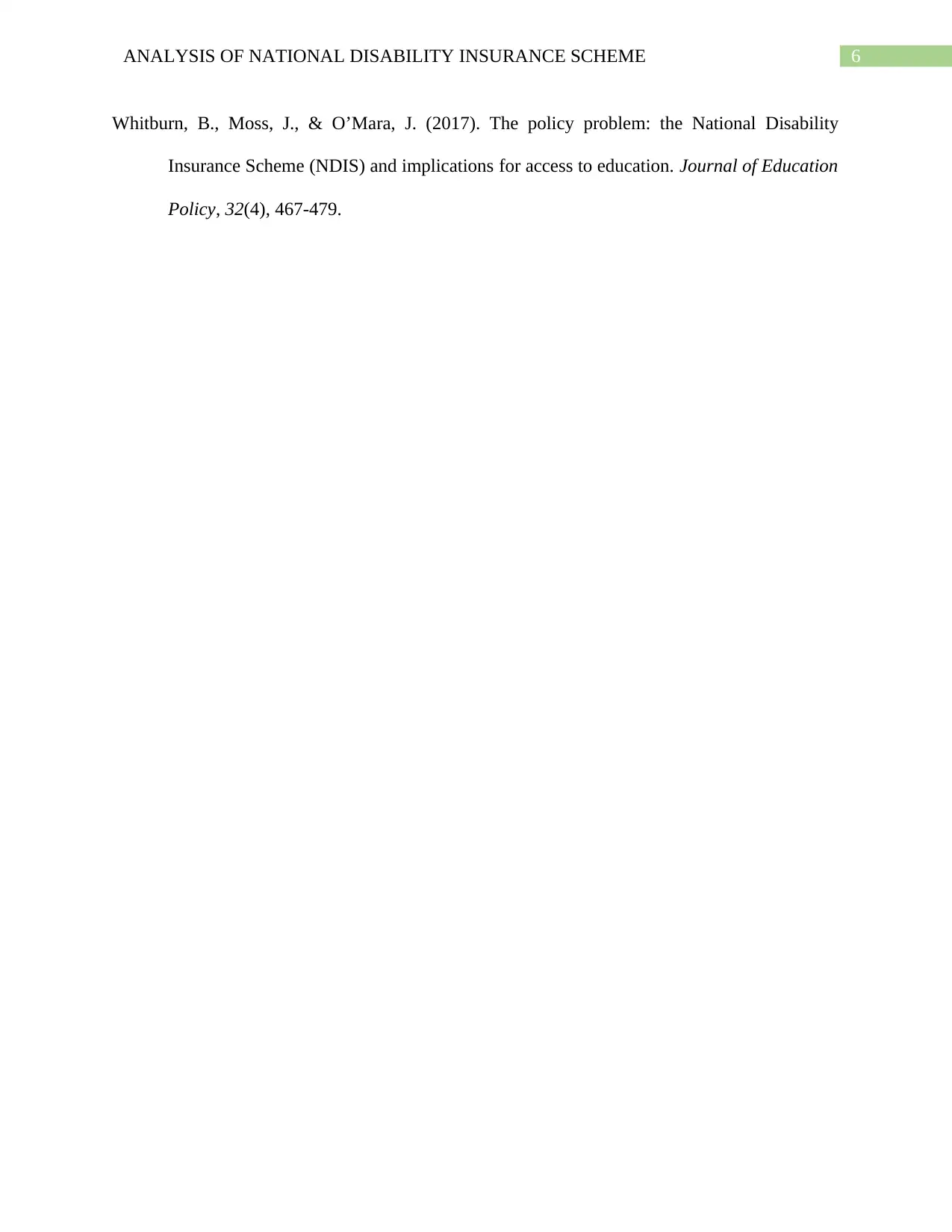
6ANALYSIS OF NATIONAL DISABILITY INSURANCE SCHEME
Whitburn, B., Moss, J., & O’Mara, J. (2017). The policy problem: the National Disability
Insurance Scheme (NDIS) and implications for access to education. Journal of Education
Policy, 32(4), 467-479.
Whitburn, B., Moss, J., & O’Mara, J. (2017). The policy problem: the National Disability
Insurance Scheme (NDIS) and implications for access to education. Journal of Education
Policy, 32(4), 467-479.
1 out of 7
Related Documents
Your All-in-One AI-Powered Toolkit for Academic Success.
+13062052269
info@desklib.com
Available 24*7 on WhatsApp / Email
![[object Object]](/_next/static/media/star-bottom.7253800d.svg)
Unlock your academic potential
Copyright © 2020–2025 A2Z Services. All Rights Reserved. Developed and managed by ZUCOL.





